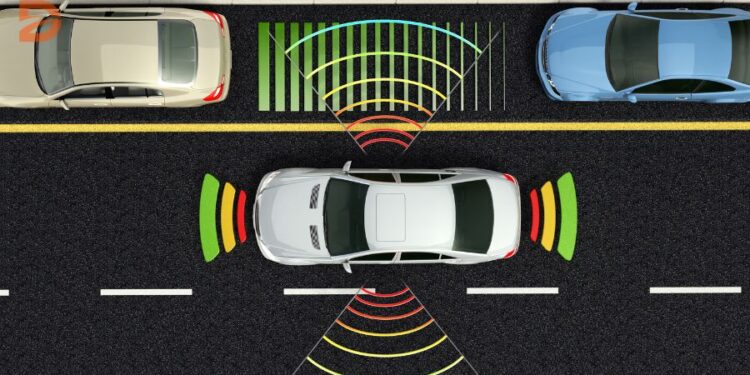Have you ever found yourself circling the block, desperately searching for an elusive parking spot? You’re not alone. Up to 30% of traffic in inner-city areas is attributed to drivers looking for a place to park their vehicles. This not only wastes time and patience but also contributes to increased traffic congestion and environmental pollution. But what if there was a solution that could make parking a breeze and alleviate this problem? Enter the revolutionary world of parking sensors.
Intelligent parking systems powered by advanced sensors are poised to transform the way we park our cars. These cutting-edge technologies are quickly becoming the driving force behind a lucrative market segment. According to a report from consulting firm Frost & Sullivan, the smart parking market in Europe and North America generated revenues of around $7 billion in 2014, and this figure is projected to reach an astounding $43 billion by 2025. The race is on, and a plethora of companies are working tirelessly to develop innovative parking solutions that will make parking a hassle-free experience for drivers.
Key Takeaways
- Parking sensors can revolutionize the parking experience by reducing traffic congestion and environmental pollution caused by drivers searching for parking spots.
- The smart parking market is a rapidly growing industry, with revenues expected to reach $43 billion in Europe and North America by 2025.
- Parking sensors utilize advanced technologies, such as ultrasonic and electromagnetic systems, to detect available parking spaces and guide drivers to their destinations.
- Parking sensors offer a range of benefits, including easy installation, weather resistance, and long-lasting battery life, making them a practical and reliable solution for urban areas.
- Leading companies are actively developing and deploying parking sensor systems in cities and commercial properties, transforming the way we park our vehicles.
Introduction to Parking Sensors
Parking sensors are advanced proximity detection devices that utilize various technologies, such as ultrasonic, electromagnetic, or radar, to sense the presence of vehicles and objects around a car. These sensors are designed to enhance driving safety and make parking a more seamless experience for drivers.
What are Parking Sensors?
Parking sensors are essentially proximity sensors that are installed on the front and rear of a vehicle. They help drivers navigate and park their cars safely by providing visual and audible alerts when obstacles are detected in the vicinity. These sensors are strategically placed to monitor the surroundings and assist the driver in maneuvering the vehicle into tight spaces with ease.
Benefits of Parking Sensors
Parking sensors offer a range of benefits to drivers, including improved safety, easier parking, and reduced risk of collisions. By providing real-time feedback on the proximity of surrounding objects, these sensors enable drivers to park with greater confidence and efficiency, making the entire parking process hassle-free. Some of the key benefits of parking sensors include:
- Enhanced safety by detecting obstacles and pedestrians, reducing the risk of collisions
- Easier navigation and parking in tight spaces, thanks to the visual and audible alerts
- Reduced stress and anxiety during the parking process, leading to a more enjoyable driving experience
- Improved fuel efficiency by minimizing the need for repeated parking attempts
- Compatibility with various parking assistance technologies, such as backup cameras and self-parking systems
In summary, parking sensors are a valuable technology that can greatly enhance the driving and parking experience for today’s car owners. By leveraging advanced sensor technology, these systems help drivers navigate their vehicles with greater ease and safety, making parking a hassle-free task.
The Growing Demand for Smart Parking Solutions
The demand for smart parking solutions is steadily increasing, driven by the need to address the challenges of urban congestion and the inefficient use of parking spaces. As the world becomes more connected and autonomous vehicles gain traction, there is a growing emphasis on developing intelligent parking systems that can optimize the utilization of available parking spaces, reduce traffic congestion, and provide a seamless parking experience for drivers.
According to recent industry data, the global smart parking systems market was valued at USD 6.49 billion in 2022 and is expected to grow at a compound annual growth rate (CAGR) of 22.1% from 2023 to 2030. This growth is fueled by the increasing adoption of IoT-based technology, the rise in the number of vehicles on the road, and the escalating parking issues faced by urban centers worldwide.
The smart parking market is poised for significant expansion, with the segment for parking guidance systems accounting for over 75% of the market share in 2022. Similarly, the analytics solutions segment is expected to exhibit a CAGR of 25.2% during the forecast period, as cities and parking operators seek to leverage data-driven insights to optimize their parking management strategies.
| Segment | Market Share / CAGR |
|---|---|
| Smart Meters | Over 40% market share in 2022 |
| Cameras & License Plate Recognition (LPR) | 23.3% CAGR during the forecast period |
| Parking Guidance Systems | Over 75% market share in 2022 |
| Analytics Solutions | 25.2% CAGR during the forecast period |
| Engineering Services | Over 60% market share in 2022 |
| Mobile App Parking Services | 26.2% CAGR during the forecast period |
The growing demand for smart parking solutions is further underscored by the increasing adoption of these technologies in commercial and government sectors. The commercial segment dominated the market in 2022, accounting for over 42% of the revenue share, while the government segment is expected to witness a significant CAGR of 23.9% during the forecast period.
The implementation of smart parking systems has demonstrated tangible benefits, such as a reduction in CO2 emissions by 10% in areas using these solutions, and a 30% decrease in search time for parking in cities like Los Angeles and Houston. As municipalities and parking operators continue to partner with technology providers, the smart parking market is poised to experience robust growth in the coming years, driving efficiency, sustainability, and a more seamless parking experience for drivers.
Types of Parking Sensors
As the demand for smart parking solutions grows, two primary types of parking sensors have emerged as reliable and efficient options: ultrasonic parking sensors and electromagnetic parking sensors. Both technologies offer unique advantages in enhancing the parking experience for drivers.
Ultrasonic Parking Sensors
Ultrasonic parking sensors utilize high-frequency sound waves to detect the presence and distance of objects around the vehicle. These sensors are typically mounted on the front and rear bumpers of the car, emitting sound waves that bounce off nearby objects. By analyzing the time it takes for the sound waves to return, the sensors can determine the distance to the object and provide the driver with visual and audible alerts. Ultrasonic parking sensors are widely used in various vehicle models due to their reliability, accuracy, and cost-effectiveness.
According to industry data, ultrasonic parking sensors typically rely on 4 to 6 sensors installed on the rear bumper of the car. These sensors can detect objects from a distance of 1.5 meters, and the parking sensor alarms generally sound at a distance of 1.5 meters, becoming louder at 0.5 meters or less. This technology is considered advanced and safe, even for novice drivers, providing a seamless parking experience.
Electromagnetic Parking Sensors
In contrast, electromagnetic parking sensors use changes in the Earth’s magnetic field to detect the presence of a parked vehicle. These sensors are often embedded in the ground or installed on the surface of a parking space, allowing them to accurately identify whether a space is occupied or vacant. Electromagnetic parking sensors are commonly used in smart parking systems, as they can provide real-time data on parking availability, which can be optimized to guide drivers to available spaces. This technology is particularly useful in large parking facilities, where traditional visual detection methods may be less effective.
According to the latest industry statistics, electromagnetic parking sensors are commonly used for the latest car models, as they offer a more advanced and reliable parking management system. This technology is considered a crucial component of the growing demand for smart parking solutions, enhancing the overall parking experience for both drivers and parking facility operators.
Parking sensors, easy parking
Parking sensors play a pivotal role in transforming the parking experience, making it both easy and convenient for drivers. These innovative technologies provide real-time feedback on the proximity of surrounding objects, empowering drivers to navigate tight spaces, avoid collisions, and park their vehicles efficiently.
Whether you’re backing into a tight spot or parallel parking, parking sensors offer invaluable parking assistance, allowing you to maneuver with confidence and reduce the stress and frustration often associated with parking. This revolutionary technology has truly revolutionized the way we approach parking, making it a seamless and enjoyable part of the driving experience.
From the advanced chipset with a detection range of up to 4 feet to the solar-powered sensor with standby mode for battery preservation, parking sensors are designed to deliver a stress-free parking experience. With features like no-drilling installation and a weather-resistant IP67 rating, these sensors offer a hassle-free solution that can be easily integrated into your vehicle or garage.
The benefits of parking sensors extend beyond just convenience. They also contribute to safer driving by helping drivers avoid collisions and potential property damage. By providing visual and auditory cues, these sensors empower drivers to make informed decisions, ensuring a parking convenience that is both efficient and secure.
Whether you’re a seasoned driver or a newcomer to the world of parking, investing in a reliable parking sensor system can transform your parking experience from a hassle to a breeze. With features like adjustable distance settings, color-coded LED signals, and user-friendly installation, these innovative solutions are designed to make easy parking a reality for drivers of all skill levels.
Installing and Maintaining Parking Sensors
The installation of parking sensor systems is typically a straightforward process that can be easily handled by vehicle owners or professional mechanics. Many modern parking sensor kits are designed with easy installation in mind, requiring minimal modifications to the vehicle.
Installation Process
In numerous cases, the parking sensors can be conveniently mounted on the license plate or license plate frame, eliminating the need for drilling or complex wiring. The installation often involves connecting the sensors to the vehicle’s electrical system and calibrating them to ensure accurate detection and alert functions. Some key steps in the DIY parking sensor installation process include:
- Locating the factory sensor markings on the vehicle
- Drilling holes for sensor placement
- Running wiring from the sensors to the cabin
- Connecting the sensor power to a switched 12V source
- Testing the system and calibrating the sensors for optimal performance
Maintenance and Durability
Parking sensors are designed to be highly durable and weatherproof, allowing them to withstand the elements and continue functioning effectively over time. Many modern sensors feature IP67 or higher ratings, making them resistant to water, dust, and other environmental factors. To maintain the sensors, regular cleaning and inspections are recommended to ensure they remain free of debris and continue to provide accurate detection.
In the event of a sensor malfunction or damage, they can often be easily replaced without requiring major vehicle modifications, ensuring a hassle-free parking sensor maintenance process.
Conclusion
Parking sensors have transformed the way we approach parking, making it a more convenient and stress-free experience for drivers. These innovative technologies provide real-time feedback on the proximity of surrounding objects, empowering drivers to navigate tight spaces, avoid collisions, and park their vehicles with greater confidence. As the demand for smart parking solutions continues to grow, the adoption of parking sensor technology is expected to increase, further enhancing the driving experience and contributing to the overall efficiency of urban transportation systems.
By integrating with existing city infrastructure and data management platforms, parking sensors offer valuable insights into occupancy rates, turnover, parking duration, and peak usage times. This data can be leveraged by city planners to optimize parking pricing and availability, leading to a potential revenue increase of up to 15%. Moreover, the reduction in congestion and improved traffic flow resulting from smart parking systems can contribute to a significant decrease in air pollution levels, positively impacting the environment.
With affordable options like the STKR Concepts Garage Parking Sensor, the benefits of parking sensor technology are now accessible to a wider range of drivers. From preventing vehicle damage and saving on garage repairs to assisting new drivers and freeing up valuable space, these sensors have the potential to revolutionize the parking experience. As the parking sensor market continues to evolve, drivers can look forward to a future where finding and securing the perfect parking spot becomes a seamless and stress-free task, thanks to the advancement of parking technology.
FAQ
What are parking sensors?
Parking sensors are proximity detection devices that use various technologies like ultrasonic, electromagnetic, or radar to sense the presence of vehicles and objects around a car. They help drivers navigate and park their vehicles safely by providing visual and audible alerts when obstacles are detected.
What are the benefits of parking sensors?
Parking sensors offer several benefits to drivers, including improved safety, easier parking, and reduced risk of collisions. They help drivers maneuver their vehicles in tight spaces, detect obstacles, and avoid accidental collisions with objects or pedestrians. By providing real-time feedback on the proximity of surrounding objects, parking sensors enable drivers to park with greater confidence and efficiency, making the entire parking process hassle-free.
What is driving the growing demand for smart parking solutions?
The growing demand for smart parking solutions is driven by the need to address the challenges of urban congestion and the inefficient use of parking spaces. With the increased adoption of connected and autonomous vehicles, there is a growing emphasis on developing intelligent parking systems that can optimize the utilization of available parking spaces, reduce traffic congestion, and provide a seamless parking experience for drivers.
What are the different types of parking sensors?
There are two main types of parking sensors:
1. Ultrasonic parking sensors, which use sound waves to detect the presence and distance of objects around the vehicle.
2. Electromagnetic parking sensors, which use changes in the Earth’s magnetic field to detect the presence of a parked vehicle.
How do parking sensors make the parking experience more convenient?
Parking sensors play a crucial role in making the parking experience hassle-free and convenient for drivers. By providing real-time feedback on the proximity of surrounding objects, these sensors help drivers navigate tight spaces, avoid collisions, and park their vehicles efficiently. Whether it’s backing into a tight spot or parallel parking, parking sensors empower drivers to maneuver with confidence and reduce the stress and frustration often associated with parking.
How is the installation and maintenance of parking sensors?
The installation of parking sensors is typically a straightforward process that can be done by the vehicle owner or a professional mechanic. Many modern parking sensor kits are designed for easy, plug-and-play installation, requiring minimal modifications to the vehicle. Parking sensors are also designed to be durable and weatherproof, allowing them to withstand the elements and continue functioning effectively over time. Regular cleaning and inspections are recommended to ensure they remain free of debris and continue to provide accurate detection.











